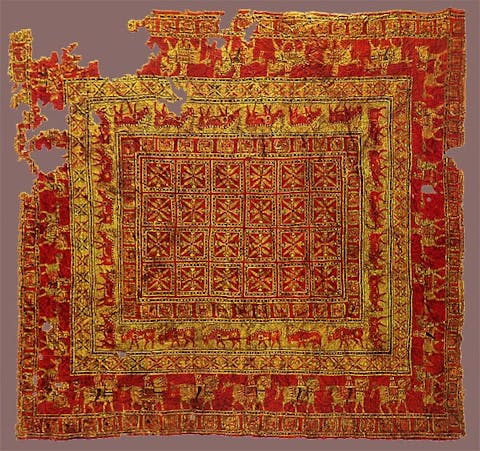Oriental Carpets & Rugs
Oriental rugs have been a worldwide favourite amongst collectors and homeowners for centuries, appreciated and enjoyed by royalty and non-specialists as works of art and items of elevated luxury and status. Do you own oriental carpets or rugs you may have picked up at a flea market, or perhaps something you've inherited? If so, Value My Stuff will happily value your items.
Original Carpets and Rugs
Carpets and rugs from Asia have been popular in Western culture and markets for hundreds of years; the famous 16th-century German-born painter Hans Holbein, renowned for his portraits of famous Brits such as Henry VIII, even has a style named after him for the significance of these carpets in his desirable portraits. The demand for carpets from all over Asia only grew from Europe in the following centuries, and good examples of rugs and carpets from Persia, the Ottoman Empire, Central Asia, and the Far East still fetch high prices today.
Follow these easy steps to value your oriental carpets and rugs.
Persian and Caucasian Carpets
The early traditions of Persian and Caucasian rugs and carpets were linked by their connection with the ancient silk road. As the Safavid Empire (1501-1732) expanded, Caucasian tribes interacted with the empire through both politics and trade. The great cities of carpet manufacture, such as Kashan and Isfahan, grew during the Safavid period. The nomadic and semi-nomadic tribes of the Caucasus shared various design features with iconic Persian designs, including Chinese motifs such as dragons, cranes, and cloud bands. Recognizably Persian styles such as the 'vase' type also feature in Caucasian rugs.
This, however, is where the similarities end. Caucasian carpets are not identifiable by the city but instead by district or even village, although there is a village tradition of Persian carpet-making too. Caucasian rugs feature bold, repeating designs that are recognizably geometric with high-contrast colours. Persian carpets, by contrast, will use brighter, more vivid colours with less focus on repeated geometric borders. Later town and city-produced Persian carpets featured garden-inspired designs. In some cases, such carpets will have the mark of an 'ustad' – a master carpet designer.

The world's oldest known pile carpet was found in the largest of the Pazyryk burial mounds. It's exhibited in the Hermitage Museum Saint Petersburg. (Public Domain)
Ottoman Rugs and Carpets
While most surviving old Turkish carpets date from the 16th and 17th centuries, it is thought that the Seljuk Turks brought the craft to the region when they ruled Anatolia in the Middle Ages. As in Persia and the Caucasus, there can be seen significant Chinese influence in the earliest surviving Seljuk carpets. Later, Ottoman carpets were very popular with Western collectors, and many of the styles are now known by names associated with famous Westerners who depicted or were associated with particular designs, of which the 'Holbein' style is one. The carpet motif, known as a 'gold', is the primary distinguishing feature of different Ottoman designs. Carpets of Egypt and Ushak are identifiable traditions in their own right; the former includes motifs such as the Kintamani, with the latter being recognisable for large 'star' and 'medallion' repeating patterns. As in Persia, after c.1700, carpet-making became commercialised and developed separate city and village/tribal traditions. In the 20th century, pieces became produced for the European market and became less desirable.
Central and East-Asian Carpets
Although Chinese symbolism has influenced many carpet-making traditions, rugs are not known to have been made in China before c.1600. Since then, Chinese carpets have become very recognizable for their colour scheme and developed into a mass industry for the Western market. Traditional Chinese designs feature iconic yellows and blues and often Buddhist and Daoist symbols amongst the great array of other Chinese symbols, which, unlike in other traditions, all have specific meanings. More modern Chinese carpets are relatively common and were produced in response to Western demand in the 20th century.
Carpet-making further west in Turkestan was closely linked with the societies of the great array of tribal peoples that lived there. The complex and dynamic politics and culture of the region led to the great variety in rug design, with individual tribal styles being distinguishable by their signature gold motif. As in China, later copies were made of these very individual and distinct designs that lacked the qualities of the originals. As the region came under the influence of Russia in the late-19th century and later the Soviet Union, tribal traditions died out as their community structures and nomadic lifestyles were threatened.
How To Get Oriental Carpets & Rugs Valued
Only a professional will be able to provide you with a sure and particular range of value and an up-to-date price for your Oriental Carpets & Rugs by using their experience and expertise to eliminate as much chance for misstep and error as possible. Luckily here at Value My Stuff, there are experts in the field who can provide professional valuation services so that you can take the necessary steps to discover how much your Carpets & Rugs are worth today! Start Your Carpets & Rugs Valuation Here!

